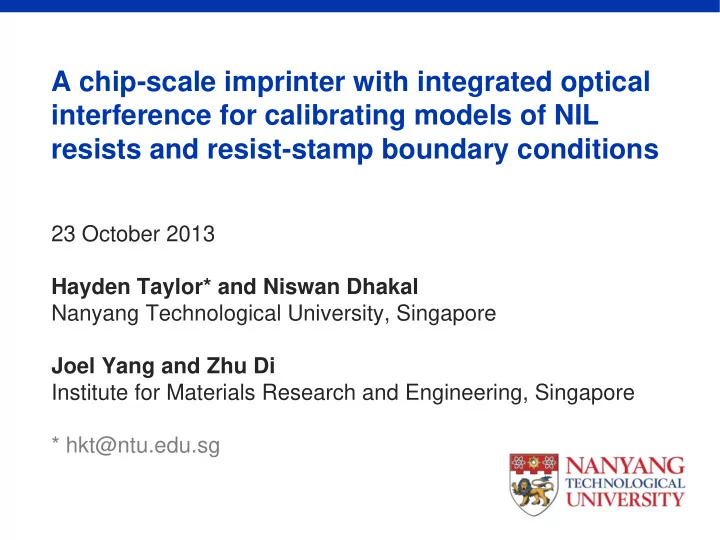

A chip-scale imprinter with integrated optical interference for calibrating models of NIL resists and resist-stamp boundary conditions 23 October 2013 Hayden Taylor* and Niswan Dhakal Nanyang Technological University, Singapore Joel Yang and Zhu Di Institute for Materials Research and Engineering, Singapore * hkt@ntu.edu.sg
Outline • Resist model calibration by fitting simulations to imprint experiments • The need for new tools to characterise resist – stamp material combinations • Real-time optical monitoring of imprint • Potential RLT sensing enhancements: • Plasmonic • Ellipsometric • Potential applications of real-time optical imprint monitoring: • Endpoint detection • Process control • Defect detection (including non-fill) 2
Our existing simulation technique quickly finds RLT and cavity-filling distributions Resist surface’s Simulations need to Example questions: impulse response be highly scalable Stamp Does changing Resist stamp material affect ~O( N 2 log N ) 1 residual layer uniformity? 1,2 10 4 Wafer Resist Time (s) 10 3 Elastomer Silicon Substrate 10 2 165 99 Stamp’s load response Stamp deflections 10 1 (bending, indentation) 2 (nm) Stamp 10 1 10 2 10 3 10 4 10 92 Simulation size, N Residual thickness Resist Can ‘dummy fill’ accelerate N (RLT) nonuniformity stamp cavity filling? 3 Incomplete cavity filling 3 Pattern abstraction 1 Density At least 10 3 times Lateral resist flow 0.5 faster than FEM RLT homogenization 4 Can trade off spatial 0 resolution and speed 1 Taylor NNT 2009, 2011; 2 Taylor SPIE 7641 2010; 3 Boning et al. NNT 2010 3
The NIL simulation technique has been experimentally validated Silicon test stamp: A B 1 mm Cavities C D (~500 nm deep) Protrusions A B E F C D E F G G H H 5
The technique has been validated for five thermoplastic materials 8 8
Nanoscale experiments may involve substantial slip between resist and stamp Assuming no slip between resist and stamp or substrate 9 9
The imprinting rate will depend strongly on any slip between resist and stamp/substrate −1 2 d𝑢 = − 𝑠 3 𝑞 0 d𝑠 𝑠 1 − 2𝜀 + 1 + 2𝜀 2 𝑏 0 4𝑙𝜃 0 𝑏 0 Laun, J. Non-Newtonian Fluid Mechanics 81 (1999) 1-15 10 10
Real-time observation of evolving RLT could accelerate material/stamp characterisation 100 µm
Real-time observation of evolving RLT could accelerate material/stamp characterisation Simulations
RLT – colour relationships are calibrated using a known stamp topography Radius = 3.1 mm Intensity gradient > 1/nm Stamp Resist Silicon 150 µm 13
Videos of the imprinting process allow the temporal response of resist to be extracted • Material: MRT mr-UVCur-21 • Stamp-average pressure 20 kPa • Consistent with viscosity ~ 7 Pa.s 100 µm 14
If features are sub-wavelength, plasmonic effects could enhance RLT detection Large features Quartz, n = 1.45 Simulated 10 nm gold h reflectivity RLT Resist, n = 1.52 spectra Silicon 25 nm-pitch dot array (Joel Yang + Zhu Di) h = D = 16 nm g = 9 nm h RLT E-field intensity D g
An anti-reflective stamp coating and light polarisation could enhance RLT contrast DLC : diamond- like carbon (n ~ 2.09). “ Polarised ” means with crossed polarisers Contrast : relative change in intensity for a 1 nm change in RLT about a given RLT Substrate-enhanced ellipsometric contrast : Ausserré, Optics Express , 15 8329 (2007) 16
Potential applications include endpoint detection and cavity filling monitoring • Endpoint detection • Feedback control in R2R processing • Cavity filling • Stamp inspection/defect detection • Probing of complex fluids ( e.g. biological samples) Partially filled cavity Resist residue 100 µm 100 µm 17
Conclusions and outlook • Resist rheological behaviour can be extracted from nanoscale imprint experiments • Resist-stamp boundary conditions are critical and require characterising • Real-time measurement of RLT can be accomplished interferometrically using simple white light microscopy • Optical RLT measurement sensitivity can be tuned using plasmonic or ellipsometric approaches • Real-time RLT measurement could be applied to improve NIL yield and throughput 18
Collaborators and acknowledgements • AMO, Germany • Christian Moormann • Ulrich Plachetka • Microresist Technology, Germany • Arne Schleunitz • Marko Vogler • Freimut Reuther • IMRE, Singapore • Goh Wei Peng • NTU, Singapore • Tan Boon Hwee • IBN, Singapore • Ciprian Iliescu • Trinity College Dublin • Graham Cross 19
Recommend
More recommend